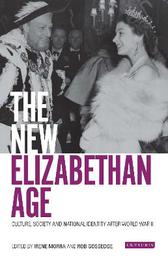
|
The New Elizabethan Age: Culture, Society and National Identity after World War II
Hardback
Main Details
| Title |
The New Elizabethan Age: Culture, Society and National Identity after World War II
|
| Authors and Contributors |
Edited by Irene Morra
|
|
Edited by Rob Gossedge
|
| Physical Properties |
| Format:Hardback | | Pages:360 | | Dimensions(mm): Height 216,Width 138 |
|
| Category/Genre | British and Irish History |
|---|
| ISBN/Barcode |
9781784531799
|
| Classifications | Dewey:941.085 |
|---|
| Audience | | Postgraduate, Research & Scholarly | |
|---|
| Illustrations |
13 colour in 8pp plates
|
|
Publishing Details |
| Publisher |
Bloomsbury Publishing PLC
|
| Imprint |
I.B. Tauris
|
| Publication Date |
30 September 2016 |
| Publication Country |
United Kingdom
|
Description
In the first half of the twentieth century, many writers and artists turnedto the art and received example of the Elizabethans as a means ofarticulating an emphatic (and anti-Victorian) modernity. By the middleof that century, this cultural neo-Elizabethanism had become absorbedwithin a broader mainstream discourse of national identity, heritage andcultural performance. Taking strength from the Coronation of a new, youngQueen named Elizabeth, the New Elizabethanism of the 1950s heralded anation that would now see its 'modern', televised monarch preside over animminently glorious and artistic age.This book provides the first in-depth investigation of New Elizabethanismand its legacy. With contributions from leading cultural practitioners andscholars, its essays explore New Elizabethanism as variously manifestin ballet and opera, the Coronation broadcast and festivities, nationalhistoriography and myth, the idea of the 'Young Elizabethan', celebrations ofair travel and new technologies, and the New Shakespeareanism of theatreand television. As these essays expose, New Elizabethanism was muchmore than a brief moment of optimistic hyperbole. Indeed, from moderndrama and film to the reinternment of Richard III, from the London Olympicsto the funeral of Margaret Thatcher, it continues to pervade contemporaryartistic expression, politics, and key moments of national pageantry.
Author Biography
Irene Morra is Reader in English Literature at Cardiff University. She holds a PhD from the University of Toronto and is the author of Britishness, Popular Music, and National Identity: The Making of Modern Britain and Twentieth-Century British Authors and the Rise of Opera in Britain.Rob Gossedge is Lecturer in English Literature at Cardiff University. He holds a PhD from Cardiff University and is the author of Arthurian Literary Production in Britain, 1800-2000.
Reviews'The 1950s New Elizabethans recognised themselves but it has taken two generations of scholars to recognise them and the contribution they made to the national identity of these islands. The New Elizabethan Age starts with the makers of the culture rather than some pale abstraction of it. Underpinning the whole scholarly enterprise is the relationship of the arts to politics. Not before time, Enid Blyton and Margot Fonteyn, Shakespeare and King Arthur have been asked constitutional questions ("Who are the British?") in a single academic study. Among a number of excellent essays on modern conceptions of British national identity, consider Arthur Aughey's fine professorial dissection of how democracies need 'elective affinity' as well as votes, against screenwriter Frank Cottrell-Boyce's first hand description of how the London Olympics opening ceremony came to behold a new nation.' - Robert Colls, Professor of Cultural History, De Montfort University, 'I was 10 during the Coronation so I'm old enough to be a New Elizabethan. I was fascinated by the examination of the phenomenon and its legacy. It's a thought-provoking and illuminating investigation of deeply embedded social and cultural habits. It's both surgery and autopsy.' - Sir Richard Eyre
|